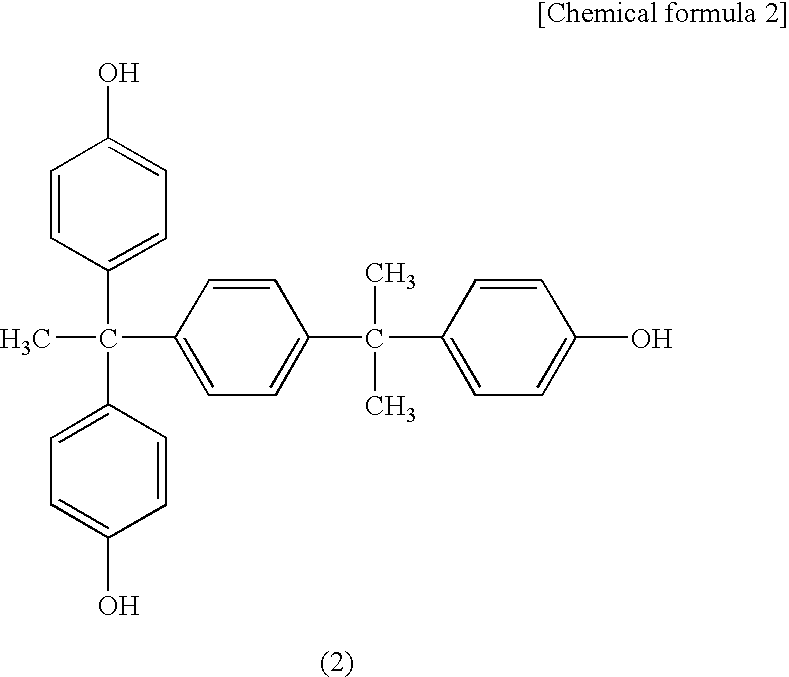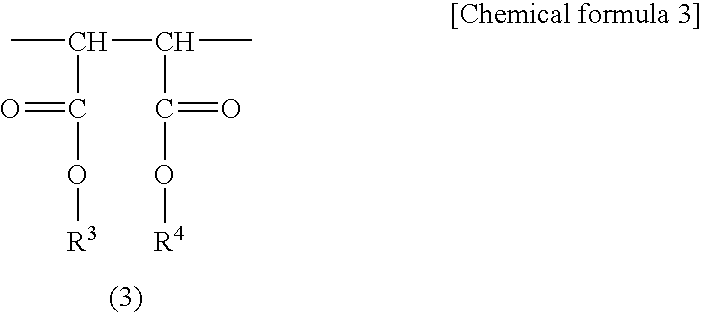Positive Photosensitive Composition
a composition and photosensitive technology, applied in the field of positive photosensitive compositions, to achieve the effect of satisfying the development, good etching factor, and easy control of compositions
- Summary
- Abstract
- Description
- Claims
- Application Information
AI Technical Summary
Benefits of technology
Problems solved by technology
Method used
Image
Examples
examples
[0068] The present invention will be more specifically described by way of working examples hereinafter. Of course, however, these examples are illustrative, and should not be interpreted to be restrictive.
examples 1 to 4
[0069] The ingredients and proportions shown in Table 1 were used to prepare positive photosensitive compositions. These were used as test photosensitive solutions.
TABLE 1ExampleExampleExampleExampleExperimentExperimentIngredients1234example 1example 2ComponentResin 1100100100—100—(A)Resin 2———100——Novolak resin—————100ComponentIR-photesensitive325133(B)dyeComponentSilane coupling1——1——(C)agent 1Silane coupling—1————agent 2Silane coupling——1——1agent 3Dissolution2222——InhibitorColor dye222222SolventPM590590590590590590IPA737737737737737737MEK589589589589589589
[0070] The components in Table 1 are as follows and proportions of each blending materials are shown in parts by weight:
[0071] Resin 1: SMA 2624 (a partial ester of a styrene / maleic anhydride copolymer with n-propanol, manufactured by SARTOMER Company, Inc.)
[0072] Resin 2: Oxylack SH-101 (styrene / semi-ester of maleic acid copolymer, manufactured by Nippon Shokubai Kagaku Kogyo Co., Ltd.; acid value: 180, melting point: 190° ...
experimental examples 1 and 2
[0097] As to Experimental example 1, the same experiment as in Example 1 were made except that the proportions of the ingredients were changed as shown in Table 1. As to Experimental example 2, the same experiments as in Example 1 were made except that the proportions of the ingredients were changed as shown in Table 1 and a 2% by weight aqueous solution of KOH was used as a developing solution. The results are shown in Table 2. As shown in Table 2, these ingredients each were lower in adhesion and poorer in etching factor than those in Examples 1 to 4.
Capability of Exploitation in Industry:
[0098] The positive photosensitive composition of the present invention is preferably used to form a positive photosensitive film on the copper sulfate surface of a plate-making roll for gravure printing. However, no particular limitation to the material on which the composition of the present invention is applied. Even if the composition is applied to plates of metals such as aluminum, zinc a...
PUM
| Property | Measurement | Unit |
|---|---|---|
| infrared wavelength range | aaaaa | aaaaa |
| thickness | aaaaa | aaaaa |
| depth | aaaaa | aaaaa |
Abstract
Description
Claims
Application Information
 Login to View More
Login to View More - R&D
- Intellectual Property
- Life Sciences
- Materials
- Tech Scout
- Unparalleled Data Quality
- Higher Quality Content
- 60% Fewer Hallucinations
Browse by: Latest US Patents, China's latest patents, Technical Efficacy Thesaurus, Application Domain, Technology Topic, Popular Technical Reports.
© 2025 PatSnap. All rights reserved.Legal|Privacy policy|Modern Slavery Act Transparency Statement|Sitemap|About US| Contact US: help@patsnap.com



